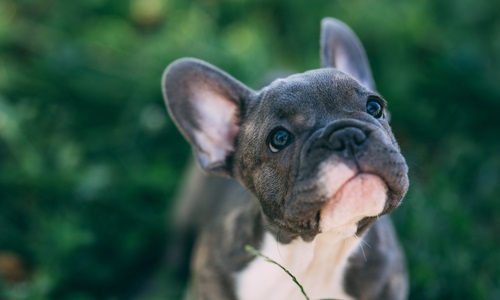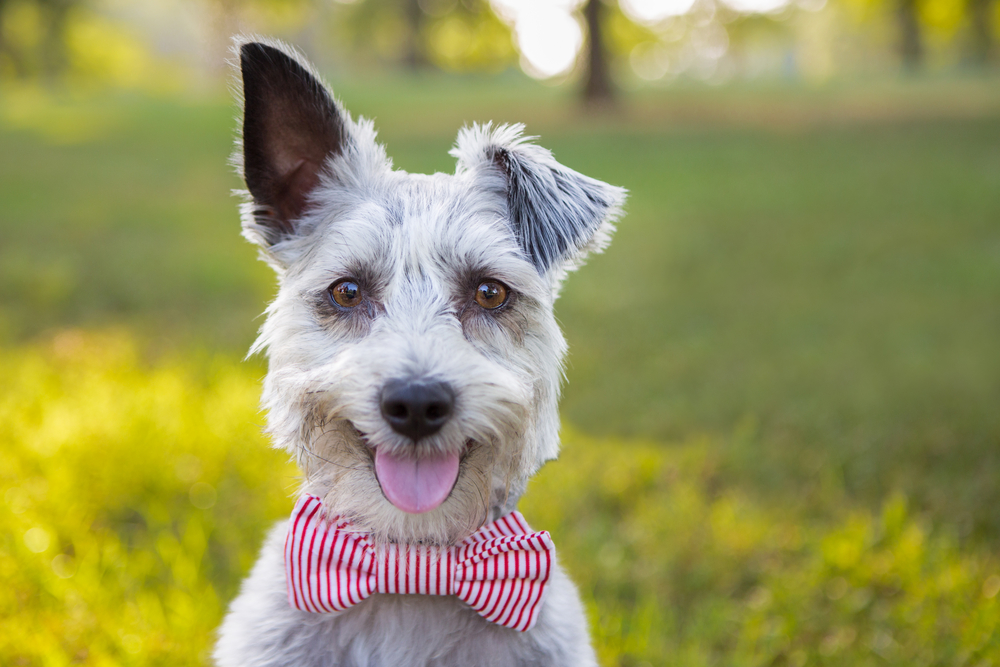A dog’s ears do a lot of important work for his survival – they pick up on any nearby threats or predators, they allow him to listen for companions approaching, and, of course, they can hear a treat bag being rustled no matter where they are. That’s why keeping them healthy and free of debris is as important as grooming his fur or cutting his nails on a regular basis.
If he’s like many dogs, however, he might balk at the idea of even his most trusted human companion touching the inside of his ears. He’s naturally protective of this area, as he is of the other vulnerable areas of his body, like his eyes or paw pads. Getting beyond this protective instinct to help him is a matter of patience and being smart about cleaning methods. Here’s how to clean out dogs’ ear linings to keep them free of parasites, diseases, and plain old dirt.
Why Do Dogs Need Ear Cleaning?
When humans bathe, the way they hold their head in the shower or bath usually rinses the outer ear naturally. As they towel off, most individuals give at least a passing scrub to the back of their ears, as well. In addition, the outside of human ears are open to sunlight and air circulation – two factors that damp, dark-loving bacteria absolutely hate. Even with those benefits, humans still need to do periodic cleaning specifically for their ears in order to remove excess earwax and dead skin.
Now imagine attaching either a cone that funnels dirt and debris directly into the ear canal, or a flap that covers the ear to give bacteria a place to hide. Dog’s ears, while excellent at funnelling sound to their inner ear for better hearing (or smells up to their nose for breeds like the Basset Hound), are also much more susceptible to infections like the candida (yeast) fungus. Regular ear cleaning helps thwart bacteria, parasites, and fungi from moving in and getting comfortable at the expense of the dog’s health and comfort.
When Do Dogs Need Ear Cleaning?
Ideally, a dog’s ears should – and often are – cleaned each time he is groomed by a professional. If his pet parent is taking a DIY approach to canine grooming and bathing, about once a month should suffice unless there’s an underlying issue. This is roughly as often as their nails should be checked and trimmed, which allows for setting up an easy-to-remember schedule for non-fur grooming practices.

Need-based ear cleaning for dogs should, on the other hand, be more immediate. When he has a canine ear infection or parasites, the natural sensitivity of his ears can make the situation absolutely miserable to endure. A dog who is exhibiting any of these signs needs a visit to the vet as soon as possible to receive an appropriate diagnosis and treatment:
- Frequent scratching at or in the ears with his paws, particularly if his paw is going into the ear canal. (Dirty, jagged claws can make this even worse!)
- Head-tilting or a previously unnoticed issue with keeping his balance as he walks
- Redness, discharge, oozing, or crusting coming from the ear area
- Evidence of rashes or parasites, such as canine ear mite crusting or black flea dirt, in the fur around his ears
- Sensitivity or reluctance to allow any contact, even light petting, around his ears
- A sharp whining or pulling away if his ears are touched
An important note on dog ear infections: Home remedies are typically not enough to fully remove serious bacteria or parasite infestations with expediency. In some cases, they may even hurt the dog – not all home remedies for dog ear issues are appropriate for every breed and situation. If any of these problems are noted in his ears, the best course of action for his comfort and health is to book a vet appointment and get a prescription for remedying the issue.
Fur Issues: How To Clean Your Dog’s Ears
A dog has a lot of fur in and around his ears – this evolutionary trait serves to filter out flying pests, dirt, and other debris. In certain breeds, overgrown facial fur can have the opposite effect, however, growing awkwardly and irritating the inner ears, or leaving them exposed. This fur can exacerbate or even cause many ear infection issues if it isn’t trimmed back regularly.
Always refer to breed-specific grooming recommendations for DIY endeavors before attempting an ear cleaning: in some cases, the trimmer may need to come out for a few passes first. Trimming fur around the lower area of his ears can inhibit the growth of yeast or bacteria, and may also inhibit parasites like fleas and mites that like to hide in his ears.
Preparing For Dog Ear Cleaning

Because ears tend to be thin, sensitive, and easy to injure on a dog, he will be very selective about who he allows to touch them. When a dog anticipates a physical altercation, this is why he will “pin” his ears back flat to his skull: it keeps them out of the way and out of reach of whatever he is fighting. This is why trust will need to be built in order to allow hassle-free ear cleaning. Follow these tips for DIY dog ear cleaning if you feel confident enough to embark upon it at home:
- Get him used to being touched and handled around his ears: Make “squinches” of his ears a regular part of petting. Avoid doing this if he has a current ear infection, of course.
- Don’t be afraid to “bribe” him with a favorite toy or treat: The goal is to keep him as still as possible and keep him from twisting away or bolting. To that end, toys that take a lot of time and licking are a great choice, such as a peanut butter/water mixture frozen into a rubber Kong-style toy. He should, ideally, associate ear cleaning with positive experiences in time.
- Pay attention to his body language and back off a little if he seems particularly uncomfortable: It’s important not to make the experience traumatic for him, as it will hopefully become a regular part of his grooming routine. While this may take time, cementing trust makes it worthwhile.
- Control the environment so he can’t run away: Close him in a small room, such as the bathroom, and get comfortable sitting on the floor at his level. This will feel less threatening or concerning to him, and increase chances for a successful ear cleaning.
Dog Ear Cleaning Techniques: During

Once he is relaxed and as comfortable as possible, grasp his ear flap firmly but gently and hold it up and open. This opens up his ear and allows you to get full access to the many niches and folds underneath. If necessary, enlist the help of a co-pet-parent to help hold him still during the cleaning process.
- Unless directed to by a vet, *do not* use specialized tools, swabs, or anything stick-like to clean the actual canal / hole of his ear. Just as humans are frequently instructed that “nothing bigger than your elbow should go into your ear,” using these tools on a dog can scratch his eardrum. Instead, stick to clean, sterile cotton rounds or gauze, available in the cosmetics section of most drugstores.
- Gently moisten your cleaning pad of choice with warm water or a vet-approved ear cleaning solution, such as Zymox. Once again, it’s best to avoid home remedies, as they can create chemical mixes that will actually do more harm than good. Unless instructed by a vet, do not pour anything directly into his ear.
- Use more disposable cleaning pads, rather than reusing the same one for both ears. If he has an infection in one ear only, using the same pad can actually spread it to the healthy ear. The same practice applies for using the same pad or pads for multiple dogs: stick to disposables to keep infections isolated.
- Once his ears are cleaned of debris, use a dry cotton pad or gauze to dab away any moisture: leaving behind a damp surface can invite harmful bacteria into the freshly-cleaned ear.
- Do not use any perfumes, oils, or lotions on his ears: if they “look dry” or have an odor, this is a symptom of a medical issue, and adding these chemicals can cause pain or infection on broken skin. In the case of any suspected medical issues, conditions or ear abnormalities, be sure to reach out to his vet right away.
A dog relies on his pet parents to do what’s best for his health, even if it’s a struggle sometimes. If he resists or is reluctant at first, just keep trying – eventually the right combination of familiarity, treats, and praise will make ear-cleaning more routine. Finally, remember that professional pet groomers are always available to assist if the DIY route proves a little difficult.
Canna Pet offers CBD pet treats, capsules and hemp oil to help your furry friend feel calm when grooming. Check out our products today!
Sources Cited:
- “How To Clean Dogs’ Ears.” Cesar’s Way (ceasarsway.com), August, 10, 2020, https://www.cesarsway.com/how-to-clean-dogs-ears/. Accessed September 5, 2020.
- Panning, Amy, DVM. “Instructions for Ear Cleaning in Dogs.” VCA (vcahospitals.com), (no published date), https://vcahospitals.com/know-your-pet/instructions-for-ear-cleaning-in-dogs#:~:text=While%20holding%20your%20dog’s%20ear,out%20of%20the%20ear%20canal. Accessed September 5, 2020.
- “6 Easy Dog Ear Cleaning Tips You Should Try.” Pet Central (petcentral.chewy.com), November 2, 2017, https://petcentral.chewy.com/health-grooming-6-easy-dog-ear-cleaning-tips-you-should-try/. Accessed September 5, 2020.
- “Discharge From a Dog’s Ear: Causes and Treatments.” FETCH by WebMD (pets.webmd.com), (no published date), https://pets.webmd.com/dogs/dog-discharge-ear#1. Accessed September 5, 2020.




